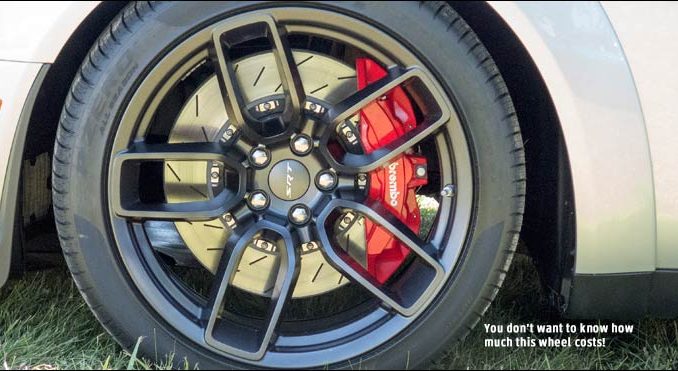
Where should you buy car parts? It depends on what you need them for, generally speaking, and how much time you have before you need them.

Regardless, it’s good to find the part number — preferably from the old part. Most of them have a number stamped or inked on. The full part number can change and be superseded by a new, improved piece; some companies append the number with letters to show revisions. This can be very handy for saving time, but can also help where an automaker had numerous different versions of the same car, each with its own special pieces.
For suspension or brake parts, I prefer to return to the manufacturer, even though few of them actually make their own. To a large degree this is a safety issue, particularly with regard to brakes, but for suspensions, there’s a second reason. An automaker may have twelve different part numbers available for different versions of a car, while the aftermarket has a single number. That’s because each model or trim of a car may special tuning, for different powertrains and such; the aftermarket may focus solely on whether the part will fit, which can result in some odd ride-and-handling changes. That’s especially true if only one part of a system, such as a shock absorber, is replaced. Even the most reputable companies do this — even the ones who supply the automaker in the first place — to lower their inventory levels.

Finding the part number on the old part helps to locate the right new part
If I have time, I prefer to buy from an Internet dealer, at a discount of anywhere from 20% to 40%. It usually takes them a good long time to ship, and they don’t really take returns (or, rather, they take returns, but under absurdly poor conditions). There are other issues, including clunky back-end systems that might not always work. The same dealerships often sell on eBay, WalMart.com, Amazon, and Sears.com, sometimes with better conditions, or at least easier comparisons to other shops. Just make sure you are getting true manufacturer (OEM) parts, because there are a lot of fakes out there; that generally means buying from a dealer. (Unpaid endorsement: I’ve done a lot of business with Koller in Virginia Beach, which does Chrysler, Ford, Kia, and Nissan. Like most of these dealers, they only give the discount for mail order. If you show up in person, you won’t get the discount.)
Spark plugs and many other maintenance parts are invariably made by a few companies you can buy from yourself, anywhere, and save a good deal of cash. I’ve switched from getting Trico blades to “store brand” from AutoZone and such, because they seem to last as long and work as well. They do seem very prone to dry rot, so age is a factor. I used to rely on Sears for batteries, but relying on Sears for anything now seems foolish; that said, when buying a battery, it’s worth spending more. The higher quality batteries can literally last years longer than the cheaper ones… speaking from experience, again. I’ve yet to have a good battery die before six years were up, while AAA apparently thinks three years is the norm.

I’m willing to buy many other parts from anyone who sells them, but I’ve had some issues. A third-party rear-view mirror, from a “reputable” maker, shook like mad and didn’t really fit. The original part came in two pieces, and theirs came in just one, which was almost molded to fit the car. That might be why the automaker wanted $120 for theirs and the aftermarket company wanted just $40.
For replacement wheels, you have many choices. You can get yours “re-rounded,” which can work but might not; sometimes they are too far gone. You can go to the dealer and spend big money, or to Tire Rack and either get a decent quality wheel for large wads of cash or a cheap Chinese import that might or might not last a year. On the other hand, there are hundreds of wrecking yards across the country, most of which sell wheels. I’ve now purchased five wheels from wrecking yards, and each one looked absolutely perfect — in mint condition. They made a big difference in the ride of our ten year old car, which had made too many trips into Jersey City and Manhattan (the fifth one was for a different car). The cost of these was $50 each, drop-shipped, and they were the same premium wheels that would have cost around $850 each, new.
Wrecking yards (or junkyards, or auto recyclers) are a fine choice for many parts, including interior pieces, certain sensors, and other electronics. The ideal is to go to a self-picking yard, but there are few of those in some regions; the industry has moved to customers going to a little shed and professional pickers getting what they need. This can be the best way to get body parts after a crash, too, since aftermarket parts often have fit issues; and aftermarket headlights may not have good light patterns, even if they seem to fit as well as the originals, according to lighting expert Daniel Stern.
Do you want a list of parts vendors in this space? If so, write a comment below, and maybe it’ll magically appear.

David Zatz has been writing about cars and trucks since the early 1990s, including books on the Dodge Viper, classic Jeeps, and Chrysler minivans. He also writes on organizational development and business at toolpack.com and covers Mac statistics software at macstats.org. David has been quoted by the New York Times, the Daily Telegraph, the Detroit News, and USA Today.

Leave a Reply